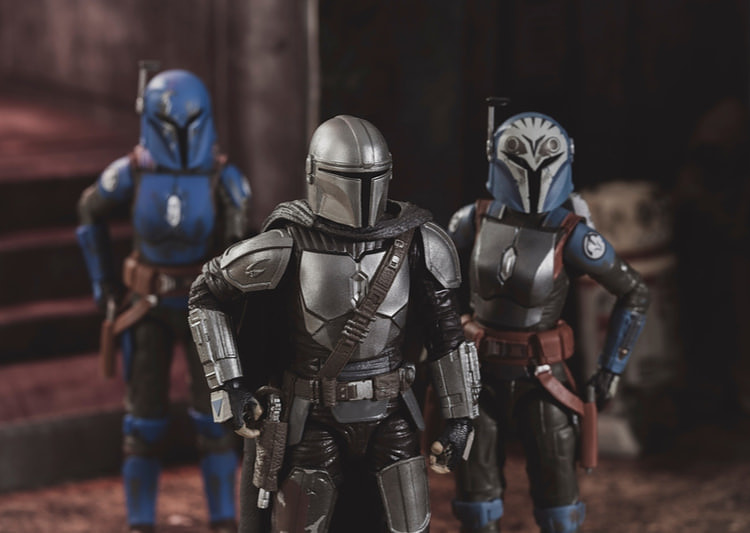The Mandalorian is the hit new Star Wars series streaming on Disney+ that has fans raving about its characters and storyline. The main character, Din Djarin, is just one of the Mandalorians shown in the series, but his presence proves to be more than just a faceless figure.
Mandalorians wear armor like that of Boba Fett, except the armor actually originated with the warriors on Mandalore. It comes with a fully covered helmet, making it impossible to see any Mandalorian’s face when they have it on…
And they always have it on.
As part of the Mandalorian code, it is forbidden for a Mandalorian to remove their helmet. This rule is strictly enforced, but why does it exist in the first place?
To give a quick answer, Mandalorians can’t remove their helmet because it goes against the code of The Way. They are forbidden from removing their helmet to protect the identity of the group and to uphold the disciplines that all Mandalorians live by.
Do you still have questions? Read on to learn more about the Mandalorians and their ancient code.
Table of Contents
What Happens if a Mandalorian Takes Off Their Helmet?
Once a Mandalorian removes their helmet, they are cut off from the tribe and treated like an outsider. There’s only one way to redeem their honor and rejoin The Way, and that’s by washing in the living waters beneath the mines of Mandalore.
The Armorer tells Din Djarin that he’s no longer a Mandalorian after it’s revealed that he removed his helmet, disobeying The Way. However, the Armorer doesn’t tell Din Djarin to return his armor or hand over the dark saber, thus leaving his Mandalorian status in question.
Although removing their helmet is strictly forbidden, Din Djarin’s attitude toward the rules strays slightly in later episodes of The Mandalorian. At the beginning of the series, he is very dedicated to The Way, but as time goes on he bends the rules.
Din Djarin removes his helmet several times during the series and even does so willingly at points.
It’s possible that characters like Grogu and Bo-Katan have both challenged Din Djarin’s view of his religion and softened his heart. However, his dedication to The Way is far from gone.
What Is The Way?
The Way is a code of ethics followed by orthodox Mandalorians. These strict rules are set to uphold the ancient traditions of Mandalore.
Many view those who follow The Way to be part of an extremist cult, clinging to relics of a forgotten age. The Children of the Watch are one such group that follows The Way with rigorous discipline.
Those who follow The Way consider those who don’t to be false Mandalorians. These groups are actively trying to reestablish the old ways and get all Mandalorians to adhere to The Way.
Mandalorians swear an oath to uphold The Way. Simply put, these rules are put in place to protect those who claim their creed.
In many ways, The Way is similar to the Ten Commandments of the Bible, but for Mandalorians. By following these rules, they protect their community and sustain the tenets of their religious beliefs.
One of these rules orders that Mandalorians are not to remove their helmet under any circumstance, other than if they’re alone and out of sight. This allows them to remove their helmet to eat and drink while keeping their identity hidden from the rest of the world.
This rule is partially in place to help protect the followers of The Way, but it also adds to the anonymity of their attire.
They all dress in similar armor, making it hard to distinguish one Mandalorian from another. With their identity stripped down to the group, the individual disappears.
While following The Way, there is no selfish ambition. The group’s goals exist for the benefit of their tribe.
Both their attire and their mantra reduce them to faceless soldiers and religious zealots, selfless warriors built for mutual protection.
However, not all Mandalorians follow The Way. That level of intense dedication is reserved for disciplined sects of the religion.
Although some Mandalorians have abandoned the old ways for a more modern, individualistic way of life, Din Djarin has claimed, “there is only one way: The Way of the Mandalore.”
Are Mandalorians a Race?
Mandalorians are both a race and a religious creed. This can be divided into two groups: Those who are born on Mandalore, and those who practice The Way.
Those born on the planet of Mandalore are inherently Mandalorians. They are born into their warrior race with the same customs and creed that all Mandalorians follow.
Some that are not born on Mandalore can still be considered Mandalorians if they follow The Way. The foundlings are a great example of people who weren’t born a Mandalorian but were adopted by the Mandalorians and became one of them by following their religion.
However, some purist Mandalorians believe you have to be born on Mandalore to be a proper Mandalorian. Likewise, some zealots believe you have to follow The Way to be a legitimate Mandalorian.
Conclusion
The rule to never remove your helmet is a strict one, and it’s part of what sets the extremist Mandalorians apart from other groups. However, the rewards for their intense dedication come at a price.
Din Djarin started out as a devout servant of The Way, but over time his moral convictions brought him further and further from the religion.
Even though he still serves Mandalore, his devotion to The Way became more complicated after he removed his helmet and was cast out from his religious sect.
Despite any bad blood between Mandalorians and their theological differences, their allegiance is unmatched. Regardless of their convictions on rules, they all embody the strength and resilience of Mandalore itself.
Whether they keep their helmet on or not, one thing is certain: Mandalorians have loyalty and power that isn’t easily shaken.
This is the way.

